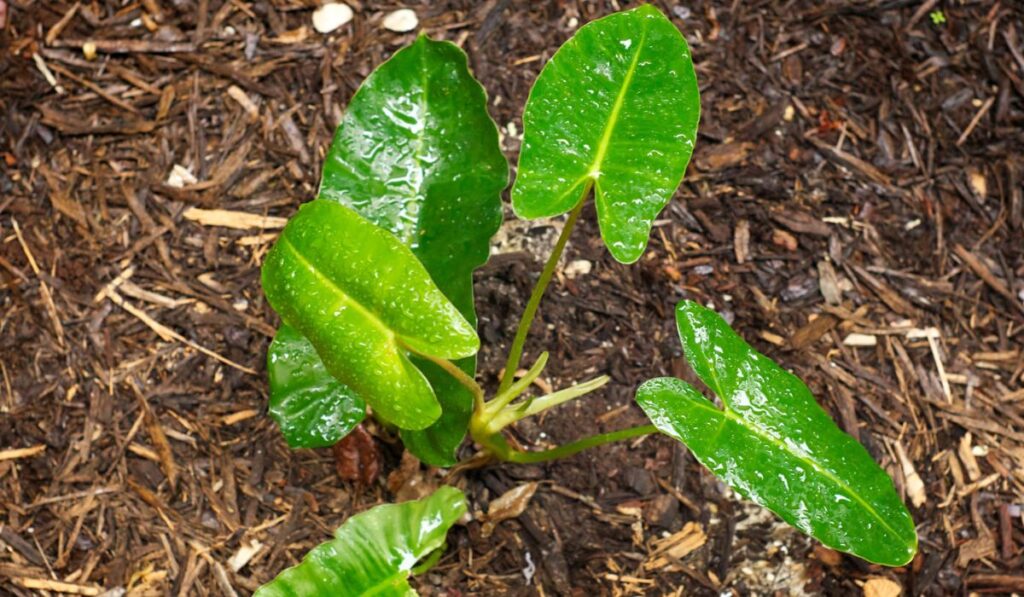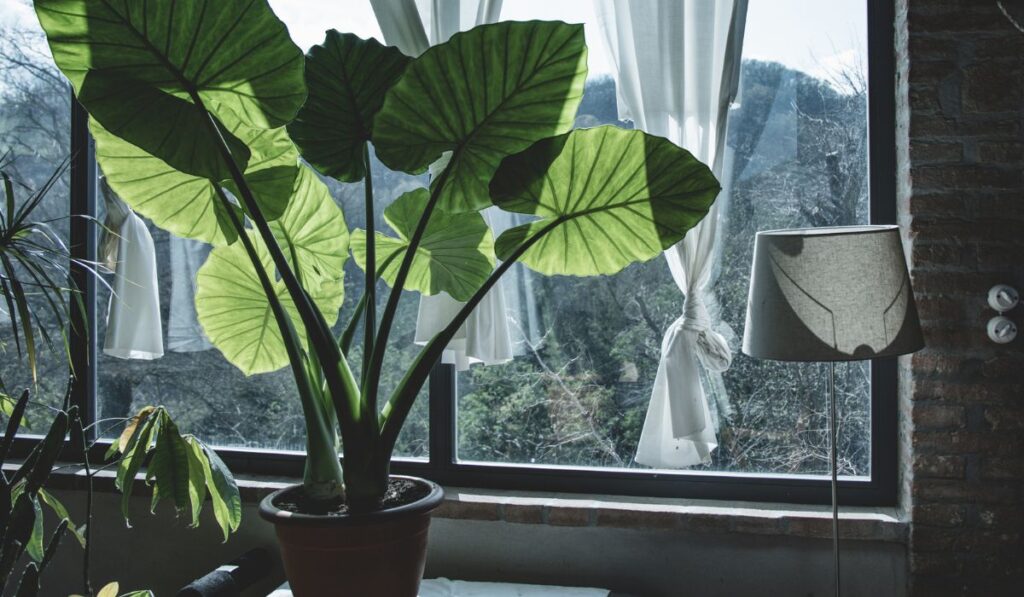Do you want to grow Elephant ear plants in your garden but don’t know how to? Or are you looking for a comprehensive planting guide for Elephant ear plants? If yes, this article is for you as it contains everything you need to know about planting Elephant Ear plants.
Elephant Ear plants grow best in rich, wet soil with lots of direct sunlight, but also some protection. This is why they’re typically placed near a structure. Plant elephant ear bulbs after the last frost. Place the bulbs 2 to 3 inches (5-8 cm) deep with the blunt end facing down.
Elephant ears are a flowering plant that thrives in warm climates. Some can survive the winter in zones as chilly as 6, while others must be pulled up and kept unless they are planted in a garden zone 9 or warmer. To successfully plant elephant ears, read further and learn more about them!
When to Plant Elephant Ears?

After any risk of frost has passed and the soil has warmed to 65 degrees Fahrenheit in the spring, you can plant your Elephant Ear bulbs (on Amazon). Most like filtered sunlight or shade, but others tolerate full sun.
On average, green varieties can sustain high light levels, but those with darker leaves require more filtered sunlight or shade.
In northern regions, this marks the beginning of June. Elephant ears can be started indoors in containers four to six weeks before they are to be planted outside. Grow them in a warm, sunny spot or under artificial light.
How to Plant Elephant Ears?
Choose a location with moist to medium soil in partial shade or filtered sunlight. In full sun and dry soil, elephant ears will suffer. Choose a site that is shielded from heavy winds. Large leaves are susceptible to damage from strong winds.
- Add compost or old manure to the soil before planting. Dig a hole two to four times the size of the tuber.
- Plant the tuber 1 to 2 inches below the soil’s surface. Elephant ears thrive when planted close to the soil’s surface. Additionally, the plant may thrive in ponds with up to 6 inches of standing water.
- Create a hole three to four times the size of the tuber. When planted, the plant’s roots should be approximately 1-2 inches below the ground’s surface.
- Place the tuber, pointed side up, in the hole and cover with soil.
- Water the area thoroughly. One to two inches of soil should cover the tuber after watering. It is important to identify where the tuber was planted, as the plant will not emerge for several weeks.
Most elephant ear plants thrive on soils modified with organic materials. Compost is a sort of organic matter that is nutrient-rich, has an optimum pH level, and can be placed in your planting space whenever you like.
If you do not have availability to compost in your region, you can create your own by covering the soil with one to two inches of organic mulch after planting and letting it decompose over time. Then, after the growing season, you can test the soil to determine what fertilizers will be necessary for the upcoming planting season. Plants should be separated by two to four feet in a garden.
Planting Locations
The elephant ear prefers moist environments, although not necessarily clear sunlight. Therefore, a somewhat shady location may be appropriate, especially if you observe leaf yellowing in a drier region. Certain Alocasia varieties do better in a greenhouse’s more stable atmosphere.
Several sun-resistant Caladium types are grown if this proves to be a problem for you. When planted in the ground, sufficient drainage is essential. Allow the higher classes of some space to grow, as some can exceed eight feet in height!
Containers, Patios, and Decks
Porches, decks, and other areas surrounding your house that do not receive direct sunlight are ideal locations for elephant ears because they provide ample shade. In addition, the huge, heart-shaped leaves give pools, spas, and water gardens a tropical ambiance.
Walls and Fences
Wind and excessive sunlight are blocked when elephant ears are planted relatively close to a wall or fence. In addition, their large leaves are utilized to soften rigid lines and add visual elements to bare walls.
Entryways
Plant elephant ears in huge planters to add a “wow” factor to your front entrance. They always leave people impressed and make a strong statement. They can be planted alone or with other plants such as caladiums or coleus.
How to Maintain Elephant Ears?
Light
Elephant ears can be grown in locations that receive full sun to part shade, but they thrive best in places that receive either partial shade or dappled sun. Darker-leaved cultivars require more sunlight to keep their color.
Soil
Elephant ears thrive in soil rich in compost and soggy with water. This plant thrives in bogs, marshes, swampland, and places surrounding water gardens.
Fertilizer
They are also big feeders and require consistent fertilization. The ideal luxuriant growth can be encouraged by applying a solution of nitrogen-rich fertilizer once per week that is reduced to only one-half the prescribed strength.
Throughout the warm months, the plant will grow new leaves; remove the oldest leaves as they begin to yellow to maintain a healthy appearance.
Water
If you are growing the bulbs in containers, you should water them every time the top inch of soil dries out. You may immediately determine the soil’s moisture content by inserting your finger several inches into potting soil. If it seems dry, add water until it runs out of the drain holes in the bottom of the pot.
Storing Tubers in the Winter
Preservation
The initial step in preserving elephant ear bulbs is to remove them from the ground. The elephant ear bulbs must be dug out of the ground undamaged to be successfully stored for the winter.
Every damage to the elephant ear bulb could cause the bulb to decompose during the winter. Therefore, to avoid damaging the bulb, it is advisable to begin digging approximately 1 foot (31 cm) away from the plant’s root and to raise the plant and bulb carefully.
When excavating elephant ear tubers, choose the largest and healthiest-looking ones. Then, after dusting them off, inspect them carefully and eliminate any that exhibit indications of insect damage or decay.
The bulbs and tubers should be dried. Before storing elephant ear bulbs or tubers, it is advisable to let them be at room temperature for one week. The moving air will dry the tubers, reducing their sensitivity to rot.
Cleaning
Step two involves washing the tubers. Use a water container to clean and remove excess grime from the items. You can buy a water container such as Wakeman Outdoors Multiuse Wash Bin (on Amazon).
Use only your hands to wipe them carefully. Scrubbing the tubers with a scrub brush can result in minor scratches and decay.
Pruning
The final stage is to eliminate excessive vegetation. Remove most of the leaves before digging up the plants. Now is the time for the last cut. Trim the stems approximately 1 to 2 inches above the tuber. The remaining will eventually dry and fall off.
In addition, you should prune excess roots and separate new offshoots that are large enough to be grown independently next spring.
Tips and Tricks

Do some research on the requirements for your variety. Some colocasias love extremely moist circumstances and may sit in up to two inches of water at the edge of a pond or water feature. Others want slightly more shade.
- It’s a good idea to plant elephant ears in an area that isn’t too dry or hot. In the chilly climates of the north, they thrive in full light.
- Elephant ear sizes range from 9 inches to more than 9 feet. Ensure that your plant has ample room to grow in your garden.
- If only a tiny piece of a leaf was broken, such as the edges, remove any discoloration or flaws by trimming along the leaf’s natural lines and contours.
- Remove dust routinely so that your plant may absorb as much light as possible. Wipe the leaves clean with a moist towel while maintaining the bottom with your other hand.
Conclusion
Elephant ear plants are native to the tropics and are grown for their foliage rather than their flowers. They can develop to full size in two months and are usually planted in the spring after all threat of frost has passed and soil temperatures have warmed to at least 65 degrees Fahrenheit.
They can also be planted in early summer. Elephant ears can be grown inside under indirect light because sunlight will damage the leaves. Ensure the soil is always wet and mist the plant to keep it humid.
